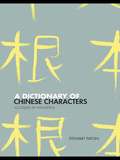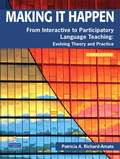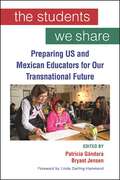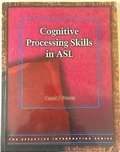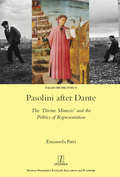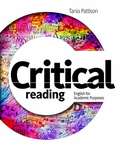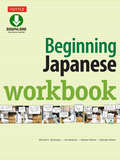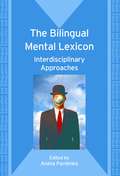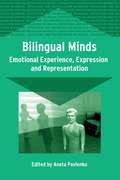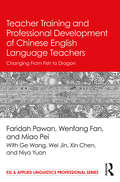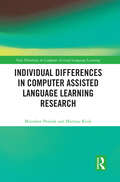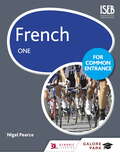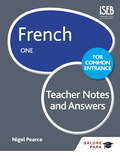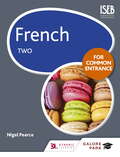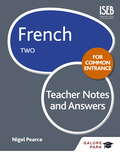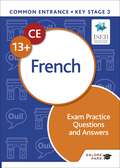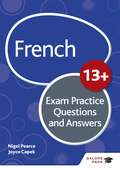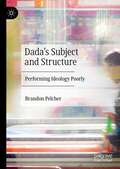- Table View
- List View
A Dictionary of Chinese Characters: Accessed by Phonetics
by Stewart PatonBy arranging frequently used characters under the phonetic element they have in common, rather than only under their radical, the Dictionary encourages the student to link characters according to their phonetic. The system of cross-referencing then allows the student to find easily all the characters in the dictionary which have the same phonetic element, thus helping to fix in the memory the link between a character and its sound and meaning. This innovative resource will be an excellent study-aid for students with a basic grasp of Chinese, whether they are studying with a teacher or learning on their own.
Making It Happen, from Interactive to Participatory: Language Teaching, Evolving Theory and Practice (4th Edition)
by Patricia A. Richard-AmatoNew to this edition: Separate chapters on implicit/explicit teaching and on a sociocultural/cognitive synthesis. New sections on focus form strategies, World Englishes, research directions, corpus analysis, dialogical assessment, and the Acoma heritage language program. The research has been updated throughout and reflects influential thinking for the 21st century. Part 1: Theoretical Considerations - Explores current theory and research; builds a case for emergent participatory teaching; and highlights literacy development, self-directed learning strategies, and current assessment issues and practices. Part II: Exploring Methods and Activities - Presents a practical reservoir from which teacher can draw as they develop their own methodologies and local practice. Part III: Putting It All Together: Some Practical Issues - Considers issues critical to program development, lesson design, textbook and computer program selection, video use; teacher research and professional development (including SOP). Part IV: Programs in Action - Describes K-Adult Programs (ESL, Foreign Language, Bilingual, and Tribal Heritage). Part V: Case Studies: Teacher Narrations to Stimulate Professional Dialogue - Presents case studies, ranging from kindergarten through university levels.
The Students We Share: Preparing US and Mexican Educators for Our Transnational Future
by Patricia Gándara; Bryant JensenMillions of students in the US and Mexico begin their educations in one country and find themselves trying to integrate into the school system of the other. As global migration increases, their numbers are expected to grow and more and more teachers will find these transnational students in their classrooms. The goal of The Students We Share is to prepare educators for this present and future reality. While the US has been developing English as a Second Language programs for decades, Mexican schools do not offer such programs in Spanish and neither the US nor Mexico has prepared its teachers to address the educational, social-psychological, or other personal needs of transnational students. Teachers know little about the circumstances of transnational students' lives or histories and have little to no knowledge of the school systems of the country from which they or their family come. As such, they are fundamentally unprepared to equitably educate the "students we share," who often fall through the cracks and end their educations prematurely. Written by both Mexican and US pioneers in the field, chapters in this volume aim to prepare educators on both sides of the US-Mexico border to better understand the circumstances, strengths, and needs of the transnational students we teach. With recommendations for policymakers, administrators, teacher educators, teachers, and researchers in both countries, The Students We Share shows how preparing teachers is our shared responsibility and opportunity. It describes policies, classroom practices, and norms of both systems, as well as examples of ongoing partnerships across borders to prepare the teachers we need for our shared students to thrive.
Cognitive Processing Skills in English (Effective Interpreting)
by Carol J. PatrieInterpret more effectively and energetically. That is the goal of top interpreter educator Carol Patrie, who writes: "Interpreters must be able to quickly make sense out of what they see and hear, decide what the message means and how to transfer that message into another language with split-second accuracy." The stronger one's English skills, the better one interprets. Effective interpreters shift more easily between English and ASL, enjoy translating, consecutive interpreting, and simultaneous interpreting more, and have more satisfied clients. Cognitive Processing Skills in English is full of challenging exercises with videotaped source materials to improve flexibility and agility with English, the kind of linguistic quickness that is essential to the interpreting process. Give yourself a comprehensive, powerful learning tool with helpful theoretical Introductions for each topic, Study Questions, and a structured Five-Step Follow-up.
The Generation of 1898 and After
by Beatrice P. Patt Martin NozickThe purpose of this anthology is to acquaint students of Spanish with some of the best writing of twentieth-century Spain. The writers known traditionally as the Generation of 1898 are presented first, beginning with Angel Ganivet and ending with Azorin, who is still alive at the time of this writing. The established figures of this generation are, we believe, represented in this text by some of their most characteristic pages.
Pasolini after Dante: The 'Divine Mimesis' and the Politics of Representation (Legenda)
by Emanuela PattiWhat role did Dante play in the work of Pier Paolo Pasolini (1922-1975)? His unfinished and fragmented imitation of the Comedia, La Divina Mimesis, is only one outward sign of what was a sustained dialogue with Dante on representation begun in the early 1950s. During this period, the philologists Gianfranco Contini (1912-1990) and Erich Auerbach (1892-1957) played a crucial role in Pasolini’s re-thinking of ‘represented reality’, suggesting Dante as the best literary, authorial and political model for a generation of postwar Italian writers. This emerged first as ‘Dantean realism’ in Pasolini’s prose and poetry, after Contini’s interpretation of Dante and of his plurilingualism, and then as ‘figural realism’ in his cinema, after Auerbach’s concepts of Dante’s figura and ‘mingling of styles’. Following the evolution of Pasolini’s mimetic ideal from these formative influences through to La Divina Mimesis, Emanuela Patti explores Pasolini’s politics of representation in relation to the ‘national-popular’, the ‘questione della lingua’ and the Italian post-war debates on neorealism, while also providing a new interpretation of some of his major literary and cinematic works.
Critical Reading: English for Academic Purposes
by Tania PattisonCritical Reading provides a systematic introduction to the process of analyzing and evaluating a written text. Students develop critical reading skills through analysis of texts from authentic sources (journals, newspapers, magazines, and websites) and a variety of academic dsiciplines. They are encouraged to develop their comprehension and vocabulary skills, while forming a reasoned assessment of the effectiveness and validity of a text.
Beginning Japanese Workbook
by Nathon Patton Lisa Berkson Michael L. Kluemper Nobuko PattonThis companion workbook to Beginning Japanese is the perfect guide for practicing basic conversational Japanese language. Written by experienced high-school Japanese teachers, it includes practice activities for reading, writing, speaking, listening and understanding Japanese:Dialogues Translation exercisesKanji practiceComprehension, vocabulary, and grammar exercisesReading practiceThe activities are varied and interesting, mirroring the book, and they help you polish every aspect of your Japanese language skills. Whether you're learning Japanese for fun, preparing for a Japanese proficiency exam, or want to achieve AP- or IB-level competency, the Beginning Japanese series is your key to becoming a confident Japanese-speaker.
The Bilingual Mental Lexicon
by Aneta PavlenkoHow are words organized in the bilingual mind? How are they linked to concepts? How do bi- and multilinguals process words in their multiple languages? The first aim of this volume is to offer up-to-date answers to these questions. Its second aim is to provide readers with detailed step-by-step introductions to a variety of methodological approaches used to investigate the bilingual lexicon, from traditional neurocognitive and psycholinguistic approaches to the more recent ones that examine language use in context.
Bilingual Minds
by Aneta PavlenkoDo bi- and multilinguals perceive themselves differently in their respective languages? Do they experience different emotions? How do they express emotions and do they have a favourite language for emotional expression? How are emotion words and concepts represented in the bi- and multilingual lexicons? This ground-breaking book opens up a new field of study, bilingualism and emotions, and provides intriguing answers to these and many related questions.
Teacher Training and Professional Development of Chinese English Language Teachers: Changing From Fish to Dragon (ESL & Applied Linguistics Professional Series)
by Faridah Pawan Wenfang Fan Pei MiaoThis up-close look at Chinese ESL teachers documents undertakings at formal and informal levels to support and sustain their expertise in ways that balance collaborative and competitive efforts, situated and standards-based programs, ethnically responsive and government-based efforts, and traditional and 21st-century teaching visions. English is a mandated subject for approximately 400 million Chinese public school students. Making transparent the training and professional development received respectively by pre-service and in-service teachers, this book provides a rare window into how Chinese English Language teachers (ELTs) reconcile the two needs with the responsibility to teach large numbers of students while also navigating societal, cultural, and institutional cross currents. It also explores the range of ways China invests in the training and professional development of its English language teachers.
Individual differences in Computer Assisted Language Learning Research (New Directions in Computer Assisted Language Learning)
by Miroslaw Pawlak Mariusz KrukThis book syntheses cutting-edge research on the role of individual differences (IDs) in the field of SLA and in computer assisted language learning. It also outlines the theoretical and methodological issues at the heart of this research, presents empirical findings and charts future directions of this research. Pawlak and Kruk provide an overview of the latest theoretical developments in research on IDs in SLA as well as methodological considerations that are crucial when researching individual variation, with special emphasis on data-collection procedures that are most prominent in CALL. The book goes on to summarize and explore a body of empirical evidence concerning the role of individual difference factors in CALL, singling out existing gaps, methodological problems, and areas in need of further investigation. Finally, the authors provide a guide on how empirical investigations of individual difference factors in CALL can be improved by incorporating latest developments from the broader field of SLA. This book will be of great interest to postgraduates and scholars in the domain of applied linguistics and second language education who are interested in CALL, as well as those studying and undertaking research in second language learning and teaching.
French for Common Entrance One
by Nigel PearceThe trusted 'So you really want to learn French' series has been completely revised and updated into a two-part French course tailored to the new ISEB syllabus. - Endorsed by the Independent Schools Examinations Board (ISEB)- Tailor lessons to the varying levels of your students, with Level 2 grammar clearly signposted, - Builds pupil confidence and mastery in grammar with clear explanations reinforced by plenty of practice exercises and handy grammar reference sections- Prepare students for their assessment with exam-style exercises throughout for listening, reading, writing and speaking- More than 70 listening tracks with new and revised audio - available as a paid-for digital download
French for Common Entrance One
by Nigel PearceThe trusted 'So you really want to learn French' series has been completely revised and updated into a two-part French course tailored to the new ISEB syllabus. - Endorsed by the Independent Schools Examinations Board (ISEB)- Tailor lessons to the varying levels of your students, with Level 2 grammar clearly signposted, - Builds pupil confidence and mastery in grammar with clear explanations reinforced by plenty of practice exercises and handy grammar reference sections- Prepare students for their assessment with exam-style exercises throughout for listening, reading, writing and speaking- More than 70 listening tracks with new and revised audio - available as a paid-for digital download
French for Common Entrance One Teacher Notes & Answers
by Nigel PearceThis PDF download provides a complete set of teacher notes, transcripts and answers to the exercises in French for Common Entrance One.- Advice on planning and delivering lessons as well as assessing progress- Audio transcripts can be used to support pupils or develop reading skills- Clear layout saves time marking work- Enables efficient assessment of pupils' strengths and weaknessesPlease note that as this product is a PDF download it is non-refundable.
French for Common Entrance One Teacher Notes & Answers
by Nigel PearceThis PDF download provides a complete set of teacher notes, transcripts and answers to the exercises in French for Common Entrance One.- Advice on planning and delivering lessons as well as assessing progress- Audio transcripts can be used to support pupils or develop reading skills- Clear layout saves time marking work- Enables efficient assessment of pupils' strengths and weaknessesPlease note that as this product is a PDF download it is non-refundable.
French for Common Entrance Two
by Nigel PearceThe trusted 'So you really want to learn French' series has been completely revised and updated into a two-part French course tailored to the new ISEB syllabus. - Endorsed by the Independent Schools Examinations Board (ISEB)- Tailor lessons to the varying levels of your students, with Level 2 grammar clearly signposted, - Builds pupil confidence and mastery in grammar with clear explanations reinforced by plenty of practice exercises and handy grammar reference sections- Prepare students for their assessment with exam-style exercises throughout for listening, reading, writing and speaking- More than 70 listening tracks with new and revised audio - available as a paid-for digital download
French for Common Entrance Two
by Nigel PearceThe trusted 'So you really want to learn French' series has been completely revised and updated into a two-part French course tailored to the new ISEB syllabus. - Endorsed by the Independent Schools Examinations Board (ISEB)- Tailor lessons to the varying levels of your students, with Level 2 grammar clearly signposted, - Builds pupil confidence and mastery in grammar with clear explanations reinforced by plenty of practice exercises and handy grammar reference sections- Prepare students for their assessment with exam-style exercises throughout for listening, reading, writing and speaking- More than 70 listening tracks with new and revised audio - available as a paid-for digital download
French for Common Entrance Two Teacher Notes & Answers
by Nigel PearceThis PDF download provides a complete set of teacher notes, transcripts and answers to the exercises in French for Common Entrance Two.- Advice on planning and delivering lessons as well as assessing progress- Audio transcripts can be used to support pupils or develop reading skills- Clear layout saves time marking work- Enables efficient assessment of pupils' strengths and weaknessesPlease note that as this is a PDF download it is non-refundable.
French for Common Entrance Two Teacher Notes & Answers
by Nigel PearceThis PDF download provides a complete set of teacher notes, transcripts and answers to the exercises in French for Common Entrance Two.- Advice on planning and delivering lessons as well as assessing progress- Audio transcripts can be used to support pupils or develop reading skills- Clear layout saves time marking work- Enables efficient assessment of pupils' strengths and weaknessesPlease note that as this is a PDF download it is non-refundable.
Common Entrance 13+ French Exam Practice Questions and Answers
by Nigel Pearce Joyce CapekExam board: ISEB Level: 13+ CE and KS3 Subject: French First exams: November 2022Improve exam technique and build confidence to ensure success in the CE 13+ French exams with these practice questions in the style of the ISEB exams.· Comprehensive practice: cover all sections and topics which could be tested in the exam for Level 1 and Level 2.· Listening exercises with free audio: authentic French voice recordings and accompanying audio transcripts.· Identify gaps in knowledge: answers are included to help pinpoint areas for improvement.Pair with Common Entrance 13+ French Revision Guide for comprehensive exam preparation (ISBN: 9781398351967).
Common Entrance 13+ French Exam Practice Questions and Answers
by Nigel Pearce Joyce CapekExam board: ISEB Level: 13+ CE and KS3 Subject: French First exams: November 2022Improve exam technique and build confidence to ensure success in the CE 13+ French exams with these practice questions in the style of the ISEB exams.· Comprehensive practice: cover all sections and topics which could be tested in the exam for Level 1 and Level 2.· Listening exercises with free audio: authentic French voice recordings and accompanying audio transcripts.· Identify gaps in knowledge: answers are included to help pinpoint areas for improvement.Pair with Common Entrance 13+ French Revision Guide for comprehensive exam preparation (ISBN: 9781398351967).
French for Common Entrance 13+ Exam Practice Questions and Answers
by Nigel Pearce Joyce CapekThis book features a wealth of exam-style questions, which have been completely revised and updated for the new French ISEB Common Entrance 13+ exam beginning Autumn 2019. Exercises are differentiated by Levels 1 and 2 and are modelled on ISEB papers, covering a variety of topics. This book also includes answers to every question, as well as marking guidance.- Endorsed by ISEB for the new exam beginning Autumn 2019- Provides comprehensive practice for French at 13+ Common Entrance- Builds students' confidence and helps identify any gaps in knowledgeThe accompanying audio for this book is available free from galorepark.co.uk/frenchaudio.
French for Common Entrance 13+ Exam Practice Questions and Answers (for the June 2022 exams)
by Nigel Pearce Joyce CapekPlease note, this resource is suitable for the exams up to June 2022. New revision resources will be available from Spring 2022 for the exams from November 2022.Exam board: ISEBLevel: 13+Subject: FrenchFirst exam: Autumn 2019This book features a wealth of exam-style questions, which have been completely revised and updated for the new French ISEB Common Entrance 13+ exam beginning Autumn 2019. Exercises are differentiated by Levels 1 and 2 and are modelled on ISEB papers, covering a variety of topics. This book also includes answers to every question, as well as marking guidance.- Endorsed by ISEB for the new exam beginning Autumn 2019- Provides comprehensive practice for French at 13+ Common Entrance- Builds students' confidence and helps identify any gaps in knowledgeThe accompanying audio for this book is available free from galorepark.co.uk/frenchaudio.
Dada's Subject and Structure: Performing Ideology Poorly
by Brandon PelcherDada’s Subject and Structure argues that Dadaist praxis was far more theoretically incisive than previous scholarship has indicated. The book combines theoretical frameworks surrounding ideological subject formation with critical media and genre histories in order to more closely read Dadaist techniques (e.g. montage, irony, nonsense, etc.) across multiple works. These readings reveal both Dada’s preternatural focus on the discursive aspects of subject formation—linguistic sign, literary manifesto, photographic image, commodity form/aesthetics, which comprise the project’s chapters—and on Dada’s performative sabotage and subversion of them. In addition to highlighting commonalities between Dadaist works, artists, and chapters previously imagined disparate, the book shows how Dada simultaneously prefigured structuralist theories of subject formation and pre-performed post-structuralist critiques of those theories.
